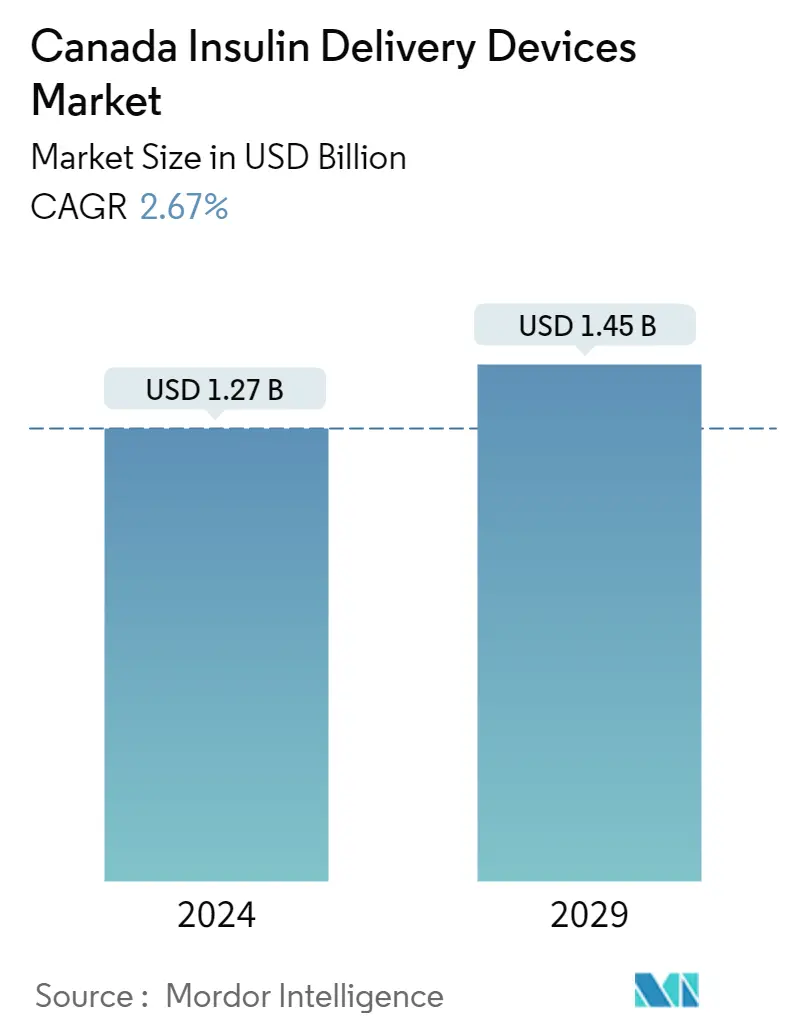Market Size of Canada Insulin Delivery Devices Industry

| Study Period | 2019 - 2029 |
| Base Year For Estimation | 2023 |
| Forecast Data Period | 2024 - 2029 |
| Market Size (2024) | USD 1.27 Billion |
| Market Size (2029) | USD 1.45 Billion |
| CAGR (2024 - 2029) | 2.67 % |
Major Players
*Disclaimer: Major Players sorted in no particular order |
Canada Insulin Delivery Devices Market Analysis
The Canada Insulin Delivery Devices Market size is estimated at USD 1.27 billion in 2024, and is expected to reach USD 1.45 billion by 2029, growing at a CAGR of 2.67% during the forecast period (2024-2029).
According to Diabetes Canada 2021, since the beginning of the COVID-19 pandemic, studies have shown that diabetes was one of the major comorbidities associated with developing severe COVID-19-related adverse outcomes and mortality. Adults with diabetes who contracted COVID-19 were at higher risk of developing adult respiratory distress syndrome, pneumonia, excessive uncontrolled inflammation responses, and a hypercoagulable state.
Early reports depicted in-hospital death from COVID-19 to be 2.85 times higher in adults living with diabetes compared to patients without diabetes. According to experts, inpatient use of diabetes technology in patients with proper institutional protocols was safe and improved inpatient glycemic outcomes and played a vital role in managing hypoglycemia and hyperglycemia in hospitalized patients.
Diabetes is a chronic condition characterized by high blood glucose levels caused by the inability to produce or use insulin effectively. The main types of diabetes are type-1 diabetes and type-2 diabetes. For a patient with type 1 diabetes, insulin therapy is important for replacing the insulin the body doesn't produce. People with type-2 diabetes or gestational diabetes need insulin therapy if other treatments, such as diabetes medications and other lifestyle changes, cannot keep blood glucose levels within the desired range.
Diabetes treatment aims to maintain healthy blood glucose levels to prevent short- and long-term complications, such as cardiovascular disease, kidney disease, blindness, and lower limb amputation. Furthermore, patients attempting to control their blood glucose levels tightly to prevent the long-term complications associated with fluctuations in blood glucose levels are at greater risk for overcorrection and the resultant hypoglycemia. Achieving nominal results can be very difficult without multiple daily insulin or insulin pump therapy injections.
Technological advancements have increased over the period in Insulin delivery devices for safer and more accurate insulin administration. Medtronic recently launched an Extended infusion set that leverages advanced materials that help reduce insulin preservative loss and maintain insulin flow and stability. The set is compatible with all MiniMed 600 and 700 series insulin pumps. The new tubing connector improves insulin's physical and chemical stability and reliability of infusion site performance and reduces the risk of an infusion set occlusion. In addition to the new infusion set, the Medtronic Extended reservoir is tested and approved to keep insulin stable and safely used for up to 7 days.
Therefore, owing to the factors above, the studied market is anticipated to grow over the analysis period.
Canada Insulin Delivery Devices Industry Segmentation
There are different ways to inject insulin into a patient's body, using syringes, pens, pumps, and jet injectors, giving them various options for insulin delivery. The Canada Insulin Delivery Devices Market is segmented into Types (Insulin Pumps, Insulin Syringes, Cartridges in Reusable Pens, Disposable Pens, and Jet Injectors). The report offers the value (USD) and volume (units) for the above segments.
| Type | |||||
| |||||
| Insulin Syringes | |||||
| Disposable Insulin Pens | |||||
| Insulin Cartridges in Reusable Pens | |||||
| Insulin Jet Injectors |
Canada Insulin Delivery Devices Market Size Summary
The Canadian insulin delivery devices market is poised for growth, driven by the increasing prevalence of diabetes and advancements in technology. Diabetes, a chronic condition characterized by high blood glucose levels, necessitates effective insulin therapy, particularly for type 1 diabetes patients. The market is influenced by the rising number of Canadians living with diabetes and prediabetes, which underscores the need for efficient insulin delivery solutions. Technological innovations, such as Medtronic's extended infusion set and reservoir, enhance the safety and accuracy of insulin administration, contributing to market expansion. Additionally, the Canadian Diabetes Strategy, a national initiative, aims to improve diabetes prevention and control, further supporting market growth.
The market is semi-consolidated, with major global and regional players like Medtronic, Insulet Corporation, and Novo Nordisk leading the charge. The insulin cartridges in reusable pens segment holds a significant market share, offering cost-effective and functional benefits over traditional insulin vials. The integration of diabetes prevention and treatment into primary health services, as recommended by the World Health Assembly, is expected to enhance access to insulin and improve diabetes monitoring. Recent strategic moves, such as Novo Nordisk's negotiations for a stake in BIOCORP and Medtronic's acquisition of EOFlow, highlight the industry's focus on expanding capabilities and addressing the diverse needs of diabetes patients in Canada.
Canada Insulin Delivery Devices Market Size - Table of Contents
-
1. MARKET DYNAMICS
-
1.1 Market Overview
-
1.2 Market Drivers
-
1.3 Market Restraints
-
1.4 Porter's Five Forces Analysis
-
1.4.1 Bargaining Power of Suppliers
-
1.4.2 Bargaining Power of Consumers
-
1.4.3 Threat of New Entrants
-
1.4.4 Threat of Substitute Products and Services
-
1.4.5 Intensity of Competitive Rivalry
-
-
-
2. Market Segmentation
-
2.1 Type
-
2.1.1 Insulin Pumps
-
2.1.1.1 Insulin Pump Device
-
2.1.1.2 Insulin Infusion Sets
-
2.1.1.3 Insulin Reservoirs
-
-
2.1.2 Insulin Syringes
-
2.1.3 Disposable Insulin Pens
-
2.1.4 Insulin Cartridges in Reusable Pens
-
2.1.5 Insulin Jet Injectors
-
-
Canada Insulin Delivery Devices Market Size FAQs
How big is the Canada Insulin Delivery Devices Market?
The Canada Insulin Delivery Devices Market size is expected to reach USD 1.27 billion in 2024 and grow at a CAGR of 2.67% to reach USD 1.45 billion by 2029.
What is the current Canada Insulin Delivery Devices Market size?
In 2024, the Canada Insulin Delivery Devices Market size is expected to reach USD 1.27 billion.

